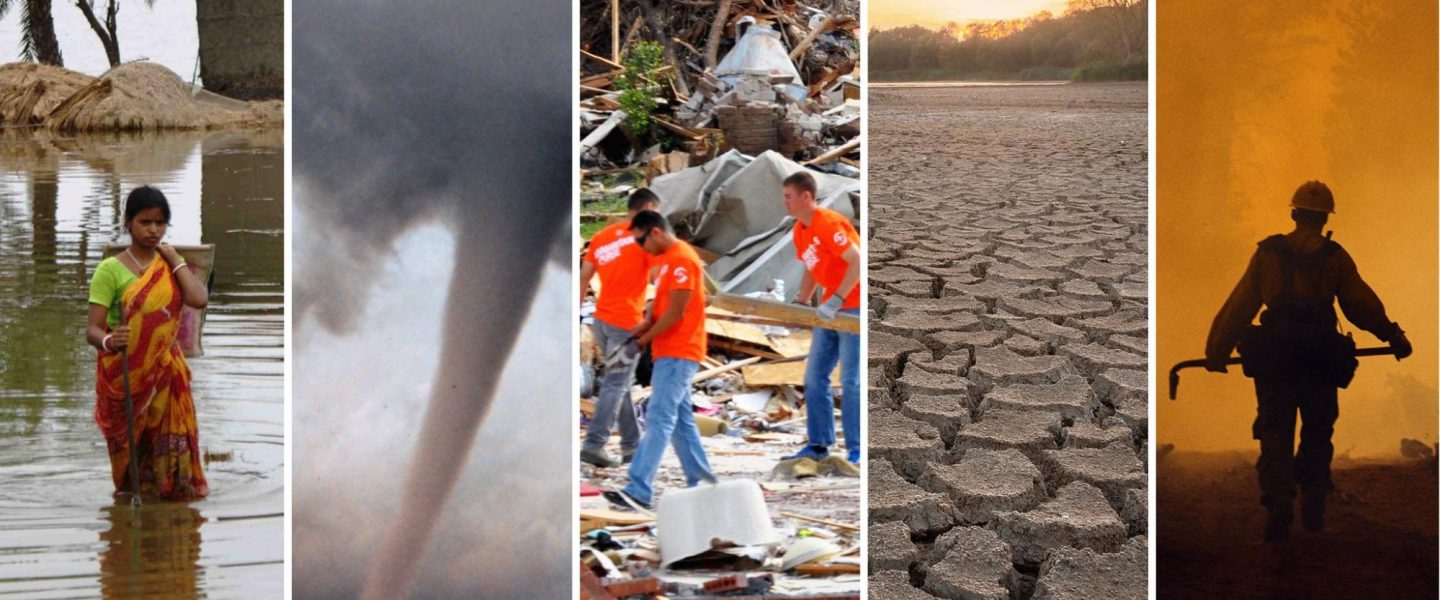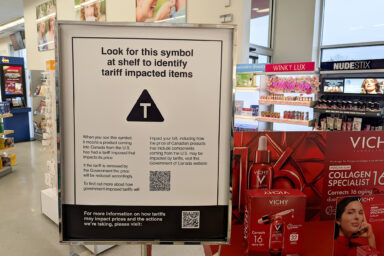Climate disasters will continue. As long as they do, we will need to focus on getting a lot better at recovering from those disasters.
With every new climate-induced disaster, we hear from politicians and government officials that “nobody expected it.” Samantha Montano calls BS on that tired refrain.
Montano, our guest on this week’s WhoWhatWhy podcast, is a professor of emergency management at the Massachusetts Maritime Academy and the author of Disasterology: Dispatches from the Frontlines of the Climate Crisis.
If we are to relieve suffering, Montano says, we must focus larger portions of our resources on disaster management and learn how to better mitigate all but certain future disasters.
She makes it clear that planning agencies like FEMA, first responders like firefighters, and disaster cleanup technologists will be far more important in surviving the consequences of climate change than splashy international summits like COP26.
 Apple Podcasts
Apple Podcasts  Google Podcasts
Google Podcasts  RSS
RSS  MP3
MP3
Full Text Transcript:
(As a service to our readers, we provide transcripts with our podcasts. We try to ensure that these transcripts do not include errors. However, due to a constraint of resources, we are not always able to proofread them as closely as we would like and hope that you will excuse any errors that slipped through.)
Jeff Schechtman: Welcome to the WhoWhatWhy Podcast. I’m your host, Jeff Schechtman. Dealing with the causes and solutions of global warming is a noble enterprise. It involves a lot of what Greta Thunberg has called blah, blah, blah. So, until we solve it, until we move beyond just talking, we had better get a whole lot better at disaster management. The summit currently taking place in Glasgow is intended to forestall the disaster of climate change. However, given the reality of how global events move, time might be better spent on climate preparedness. History has taught us that the more we know about disasters, the more we realize that most were preordained.
COVID-19 or Katrina, the fires in the West, or the deep freeze this past winter in Texas, none of them are what we would call a black swan event. So, while 400 guests gather in Glasgow, we had better spend time dealing with the consequences and aftermath of hurricanes, extreme storms, fires, droughts, floods, and extreme cold. Agencies like FEMA will be more essential than a climate summit. Therefore, the business of disaster management should be our number one priority just as it’s been for my guest, Dr. Samantha Montano. Samantha Montano is currently an assistant professor of Emergency Management at the Massachusetts Marine Academy. She holds degrees in emergency management and writes about the intersection of disasters, climate change, gender, and media. She’s written for numerous publications. Her book is Disasterology: Dispatches from the Frontlines of the Climate Crisis. And it is my pleasure to welcome Dr. Samantha Montano here to the WhoWhatWhy Podcast.
Samantha Montano: Thanks for having me.
Jeff: It’s great to have you here. Talk about this idea that so many of the crises that we face, many that you write about, are things that could have been if not literally predicted, at least easily imagined, and yet, we never seem to be appropriately prepared.
Samantha: Yes. Very often after major disasters, there is a narrative that forms in mainstream media or among politicians, which states nobody could have seen this coming. It’s not our fault. We weren’t prepared for this, nobody expected this to happen. In reality, we can look back at risk assessments that local emergency management agencies have put together, threat analyses that FEMA has done, we can look at the work that scientists and other academics have done.
And almost always, you can find somebody who was warning about nearly that exact scenario. And so, this idea that we can’t predict these disasters really isn’t true, and honestly, it’s a convenient way out for politicians, elected officials to excuse the lack of resources that they’ve put towards preparedness efforts in advance.
Jeff: And yet there’s a kind of cognitive dissonance in that because those are the very people that could benefit in terms of a positive public response if we were prepared, if we did have the ability to better deal with these events.
Samantha: Yes, you’re right. Disaster researchers have been arguing for decades, alongside emergency management practitioners, that we need to take a more proactive approach to emergency management to understanding our risk across the country. Traditionally, we have tended to be very reactive. We’ve let the disaster happen then responded to it going through this recovery process. In the ideal world though, we would spend a lot more time working on preparedness efforts, on hazard mitigation, to actually try and prevent these disasters from happening ahead of time.
When you look at the disaster research on why it is we’re not doing more to mitigate our risk to prevent these disasters from happening, one of the major issues that comes up is that for some politicians, the calculus is that the payoff for doing that mitigation may not really come to fruition while they’re still in office. And so, the public won’t really understand that the actions they’ve taken are at the root of preventing this future disaster that doesn’t happen. And so, it puts politicians in a tricky position there where they don’t really see how that could pay off politically.
Jeff: It’s also not necessarily about predicting the event or preventing the event, I suppose, but knowing that these events will happen, whether they’re fires or hurricanes, or more flooding as a result of climate change. It’s really how we’re prepared to deal with the aftermath.
Samantha: Yes. Absolutely. So regardless of the exact type of hazard that occurs, whether it’s a wildfire, a hurricane, a flood, a terrorist attack, we know that there is this process of recovery that we’re going to have to go through, that communities will need to go through. And that recovery process actually looks relatively similar regardless of what that actual hazard is. There are some logistical differences in terms of the extent of rebuilding that may need to happen or the approach you take in terms of materials. But the overarching need for a community to go through a recovery is quite similar. And because of that, we see from disaster to disaster that some of the same problems are arising time after again.
So, we know from research and experience that coordination and communication during the actual recovery is a huge challenge and can really slow down that recovery process. A lack of local leadership can cause a huge problem and delays in recovery, a lack of financial resources coming into a community. The challenges that individuals have as they try to navigate this really complicated recovery program bureaucracy, navigate through this red tape trying to access funding from FEMA or from insurance companies. That all looks pretty similar from place to place across the country.
Jeff: One of the things that seems to be true, and I’d be interested in your take on it, is the inconsistency of FEMA. They have been so good in some disasters, and so horrible in others. Talk about that.
Samantha: Yes. When we think about not just FEMA, but emergency management generally, probably the first instances that come to mind are the events where there has been these huge failures. So, we think of Hurricane Katrina, we think of Hurricane Maria, we think of even the response to the pandemic. And what we don’t think as much about, for maybe obvious reasons, are the day-to-day emergencies that happen across the country every single day that we actually respond to really well. In your local community when there is a major traffic accident or an apartment complex burns down, there generally are resources there to meet those needs.
Local first responders have trained on these kinds of scenarios, there are resources locally to come in and support, local nonprofits will come in and help. Communities move through those events relatively quickly. As we start looking at these larger disasters though, these major wildfires, these major hurricanes, there starts to become much more complexity in how we actually respond to these events. You have more organizations, more agencies from different levels of government coming into that community to be involved with that response and recovery in some way.
And as I mentioned earlier, that creates an incredible challenge in terms of coordination and communication. And so, one of the major challenges for emergency management always, but especially looking forward to the future, is how can we be doing more to have more effective communication, more effective coordination so that needs can be met in communities more effectively and more justly?
Jeff: In some ways, more emergencies which we seem to be having lately in large part due to climate change, more emergencies should make us better prepared and more on our toes to deal with these things. And in fact, it seems to have the opposite effect. It depletes resources. And we don’t seem to learn from the last disaster.
Samantha: Yes. Certainly, as you know communities are experiencing these disruptive events with a greater frequency, or at least more severity in some cases, it’s certainly the case that organizations and agencies — but even individuals that are experiencing these events — are gaining a tremendous amount of disaster experience. I did some research in southeast Texas near Houston and surrounding areas related to flooding there. They’re a part of the country that has had these repeat floods over the past several years. The volunteers that I met there had gotten used to having to respond when these flood events happen. There was a process that had emerged that they went through repeatedly of, “It’s flooding, we need to go open the shelters, we need to go knock on our neighbor’s doors who we know need help evacuating.”
And so, there’s certainly a culture and a learning within that local community. At the same time, folks there and other parts of the country that have experienced repeat disasters are tired. It’s exhausting to have to go through multiple disasters in such a short period of time at that individual level, but also as a community, and certainly in terms of the actual organizations and agencies that are having to respond to these events again and again.
Jeff: What’s happening on the academic level? The work that you do in Massachusetts, the work that’s done at the University of Pennsylvania, where I know there’s a lot of work going on in terms of looking at disaster preparedness and its economic consequences, what’s happening in the academic world in these areas?
Samantha: Well, what’s interesting about disaster research is that there’s no one discipline that studies disasters. There are historians, economists, psychologists, sociologists, anybody and everybody is studying disasters. And that is really great because we’re bringing all of these really important and different theoretical perspectives to this work. At the same time, it can sometimes make that research a bit disjointed and difficult to access, difficult to follow. I myself work within the discipline of emergency management, where we’re focused on how we actually manage these events.
So, what we need to be doing for better coordination, communication, what we need to be doing to help communities through recovery more quickly, and also on the mitigation and preparedness side as well. So, some of these more almost operational, a bit more applied research that we tend to be doing in emergency management. But the work that I do draws heavily on all of these other disciplines, and at times synthesizes the work from all of these different fields so that we can bring it more into practice.
So, from my perspective, the research that I’m working on, it does take that more applied, how can we get this research into the hands of the people who are actually doing this work on the ground as quickly as possible? And also, what recommendations can we make in terms of policy, particularly at the federal level, to try and make changes to this system as we look forward to increasing risk in the future?
Jeff: Is there a global perspective to this? Can we look around the world and see other potential best practices in other countries?
Samantha: Yes. Certainly, disasters are something that is studied across the world. Different countries take different approaches to managing disasters. Japan, for example, is known as having a much stronger culture of preparedness than we do in the United States. Certainly, there are other countries like Australia and New Zealand who have advanced emergency management systems than the way that we do in the US. At the same time, there are pretty significant cultural differences. So, we do see a sharing of ideas across countries. But there’s not one country who is necessarily doing emergency management perfectly.
Jeff: Talk a little bit about what we learned from past disasters. Which disasters of the many that you write about have we learned the most from and really been able to apply to events in the future?
Samantha: Yes, that’s a great question. In terms of academic learning, I would say Katrina and the levee failure in New Orleans. That was, in the US, an event that led to a tremendous amount of disaster research being conducted. Much of what we know about disasters from the research comes from work that was done following Hurricane Katrina. Some of that has been applied into practice, but actually moving those research findings into policy and into practice is a huge challenge one that we’re still working on every day.
Jeff: And of course, one of the things that we saw with Katrina and it has applied to other disasters, and arguably, as we see more as a result of climate change given where communities are built, it will be an ongoing issue, is the whole question of inequality in terms of response and who suffers the most in these disasters?
Samantha: Yes, absolutely. That was one of the huge findings from the body of work on Katrina, which was that not everybody experienced the same impacts. You can see disparity in terms of who actually died during Katrina. It tended to be people who were elderly were more likely to die in the flood. But you can also see that in terms of who was able to evacuate, who had access to a car, who had the money to be able to go and pay for a hotel room to stay at, who had a job, who they were able to take time off to evacuate.
And then you can also see how inequality shapes what the actual physical vulnerability of different communities are. Again, going back to Katrina, you have this difference between which neighborhood flooded, you have the white affluent uptown neighborhood not taking on water, they are higher up as compared to the Lower Ninth Ward, which had up to 18, 20 feet of water in some parts. And so, there’s a long history that led to who was living in each of those neighborhoods.
And then in the recovery as well, you can see which neighborhoods were able to recover more quickly than others. You have the whiter wealthier Lakeview neighborhood that although they had extensive damage from the flood, were able to generally move through that recovery process more quickly as compared to the Black Lower Ninth Ward neighborhood where there are still people who were unable to get through that recovery process, and still haven’t rebuilt today.
Jeff: Given that we know this, given that oftentimes it is lower-income neighborhoods, places like the Ninth Ward, that will suffer the most damage particularly in floods, and other natural disasters as well, is there something that we should be doing that we’re not doing, either from a practical perspective or a policy perspective, with regard to planning for these disasters knowing that certain neighborhoods, certain communities will suffer more?
Samantha: Yes, absolutely. I think when we’re thinking about planning efforts, the first thing we need to be really cautious about is not planning as though every community will experience the disasters in the same way, or that every community will have the same resources to respond. It’s not enough for an emergency management agency to have an evacuation plan for their city. They need to really understand how people living in different neighborhoods will actually be able to evacuate if that order is given.
There needs to be a plan in place for assistance through public evacuations, and these other elements, other evacuation programs put in place ahead of time to actually meet the needs of each community. In addition to that, we also need to see much more inclusion of local community members in planning efforts. Traditionally in emergency management, planning efforts have been done by emergency managers, by elected officials, and the profession of emergency management is very rarely reflective of the local community.
Historically, it’s tended to be white older men with military first responder backgrounds that work in emergency management agencies. And while they bring an important experience, they may not have a great understanding of what the needs of different populations within their community actually are. So not only diversifying the profession of emergency management but really making sure that local community groups, et cetera, are participating in these community planning efforts is really vital to making sure those needs are met.
Jeff: What are the most difficult kinds of disasters for planners to deal with and which are the hardest to recover from?
Samantha: Yes, that’s a good question. I think the obvious answer in terms of planning is any event that we haven’t really imagined yet, anything can happen. And like I said at the start of our conversation, almost always we have a good sense of what can happen, but we can be surprised. So, planning for the unexpected is certainly a challenge. Something more tangible though is even just thinking about how our emergency management agencies had to rework their emergency management plans at the outset of the pandemic, right? Responding to a wildfire, responding to a hurricane in the middle of a pandemic was not necessarily a scenario that had been explicitly planned for in many communities.
And so, certainly having to rework those plans for other disasters that have happened during the pandemic was a unique challenge. In terms of what is most difficult to recover from, I would say there are certainly major catastrophic scenarios which would be really difficult to recover from, but I would say on a more likely scenario when we see communities that have been through multiple disasters in a short period of time, places like Lake Charles in Louisiana, I think those recoveries can really be more difficult than if you only have one event occur.
You get stuck in this cycle where you cannot get through recovery before the next disaster happens. You’re in a place— Lake Charles is a city that doesn’t capture a lot of national media attention. There isn’t this groundswell of support going into their community a year, two years after disasters have happened there in the way that we saw in New Orleans post-Katrina. So, I actually think those disasters that are happening repeatedly in smaller cities, small towns across the country can be some of the most difficult to actually recover from.
Jeff: How do disaster planners think about people versus property in terms of how they mitigate and triage a disaster.
Samantha: Both are important as emergency planning efforts are conducted. Ideally, we are placing the most importance and the priority on saving lives, but there is an extensive amount of work that goes into planning for the protection of property as well. Really, this goes back to this issue of mitigation and really wanting to have this reorientation in the field of really focusing on hazard mitigation.
There’s a statistic that gets thrown around a lot in the emergency management world, which is, for every dollar we spend on hazard mitigation, the federal government saves $6 in response and recovery efforts. The part of that statistic that gets left out of that economic argument are the lives that are saved and the mental health toll that is saved by preventing these disasters ahead of time.
Jeff: Talk about the mental health aspect, and how much of the work of FEMA and other planning agencies goes into thinking about dealing with the mental health aftermath of these disasters.
Samantha: Yes, that was another, I think, important lesson following Hurricane Katrina, and one that was studied pretty extensively after Katrina, is this mental health component. We tend to think about the trauma of actually going through the event. But from looking at the research, we actually see that post-disaster in that recovery time period, because of how long that process can drag out because of how difficult it is, how much disruption in the long term there is for people…
At times we see increases in suicide rates, we see increases of medical issues related to increased stress, we see an increase in domestic violence. Again, these rippling repercussions, not only from the actual response to the disaster itself but into the recovery. We’ve also seen in the wake of Katrina that there is a greater emphasis on mental health from formal first responder agencies, from FEMA, from the Red Cross even. And it’s definitely a growing component, I would say, of emergency management.
Jeff: And finally, is there a sense in the disaster preparedness community, the people that you interact with, your colleagues, that given climate change right now, things are going to get so much worse?
Samantha: Yes, certainly. When you talk to emergency managers across the country, they are on the frontlines of these climate-related disasters that are happening. They’re seeing it whether it’s sea level rise on the East Coast, or changes in hurricanes along the Gulf Coast or river flooding in the Midwest, or wildfires and drought out West. There’s no part of the country that is not being affected by these disasters.
And emergency managers as well people in their communities that are supposed to be dealing with these disasters don’t have any illusions about what is happening. Sometimes I think they’re in a difficult political situation in some parts of the country as they try to explain how this risk is changing over time, but certainly, people on the frontlines, there’s no illusion as to what’s happening.
Jeff: Dr. Samantha Montano. Samantha, I thank you so much for spending time with us here on the WhoWhatWhy Podcast.
Samantha: Thanks for having me.
Jeff: Thank you. And thank you for listening and joining us here on the WhoWhatWhy Podcast. I hope you join us next week for another radio WhoWhatWhy Podcast. I’m Jeff Schechtman. If you like this podcast, please feel free to share and help others find it by rating and reviewing it on iTunes. You can also support this podcast and all the work we do by going to whowhatwhy.org/donate.
The image above was created by WhoWhatWhy from these images: India Water Portal / Flickr (CC BY-NC-SA 2.0) , NOAA Photo Library / Flick (CC BY 2.0), Forest Service, USDA / Flickr, Water Alternatives Photos / Flickr, and US Air Force.



